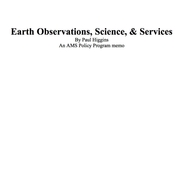By Paul Higgins ([email protected])
The views expressed in American Meteorological Society Policy Program memos are those of the author alone and do not necessarily reflect the views of the American Meteorological Society, its members, or sponsors.
Earth observations, science, and services (Earth OSS) inform and guide the activities of virtually all economic sectors and innumerable institutions underlying modern civilization. Increasingly, Earth OSS are a fundamental component of efforts to meet basic human needs including food, shelter, energy, health and safety. At the same time, the opportunities for societal benefit from Earth OSS are increasing.
Earth observations reveal a wide range of characteristics and functions of our planet. The observing system consists of ground, oceanic, aerial, and satellite-based resources. We observe physical systems (e.g., weather events, the land surface, and coastal areas), biological resources (e.g., terrestrial and aquatic ecosystems), and social institutions (e.g., agriculture, the built environment, and urban areas) like never before. These systems, resources, and institutions underpin social and economic well-being.
Earth sciences consist of basic and applied experiments conducted in the lab, field, or computer models that increase our knowledge and understanding of the Earth system. This knowledge and understanding alerts us to societal risks, informs risk management decisions, and creates new opportunities for societal advances.
Earth system services synthesize our knowledge and understanding of the Earth system (based on observations and science) and apply that knowledge to improve social and economic well-being. Services can include weather forecasts and warnings, assessment of fire risk, flood and drought monitoring and prediction, tsunami propagation modeling and forecasting, natural hazard preparedness and response, public health warnings, disease prevention and control, and decision support for policy-makers in water resources, agriculture, transportation, and other key economic sectors. Services are provided by the public, private, and academic sectors.
Earth OSS enhance social and economic well-being. For example, the agricultural sector uses Earth OSS to determine what crops to plant, which varieties to use, when to plant and harvest, and when to apply fertilizers, pesticides, and water. The energy sector relies on forecasts of summer heat and winter cold to predict consumer demands for energy and to avoid blackouts and heating fuel shortages. Earth OSS also help decision-makers identify and ameliorate harmful unintended consequences of energy production and use, such as the public health consequences associated with air pollution and climate change.
Water resource management relies on Earth OSS to determine water availability, quality, and need. Observations of temperature, precipitation, humidity, soil moisture, and stream flow provide a basis for flood warnings, operation of water management systems, water quality protection, floodplain mapping, and the design of critical infrastructure (e.g., bridges, levees, and dams).
Disaster preparedness and response efforts rely on Earth OSS for advance warning of impending extreme events (e.g., winter storms, droughts, hurricanes, tornados, floods, and heat waves) and for the assessment of the extent and duration of natural disasters. Public health uses Earth OSS to recognize when environmental conditions may lead to disease outbreaks or cause weather-related health impacts due to floods, heat waves, and extreme events.
National security depends on Earth OSS for strategic and tactical decisions involving the timing of military operations and the resource needs for troops. Furthermore, national security issues arise in parts of the world where weakened or failing states experience acute weather events, natural disasters, and climate variability and change. Earth OSS help spot these troubled regions and allow targeted efforts to provide humanitarian aid or otherwise manage conflicts with potential to spread.
Taken together, Earth OSS in the United States comprise a national asset that, if lost or degraded, will not meet future societal needs that span the whole of the national agenda. This infrastructure is not concentrated but widely distributed across Federal agencies and all levels of government, throughout an extensive and growing private sector, and in university research laboratories.
Earth OSS face notable challenges. Economic downturns and decreases in Federal investments put efforts to build and maintain our Earth OSS capabilities at risk. Similarly, the increasing cost of satellites creates challenges for NOAA, NASA, and the military. Aging of the Earth observing satellite fleet increases the potential for failures and gaps in data continuity. Satellite operations are a large fraction of NOAA’s overall budget. As a result, small expansion of satellite budgets can consume the resources needed for other programs. Users, members of the public, and even some policy makers often take Earth OSS infrastructure for granted. Therefore, demand for Earth OSS is weaker than justified by the scale of the societal benefits that result.
Improvements in Earth OSS are possible through: 1) increased investment designed to shore up and expand U.S. Earth OSS capability, 2) more effective use of limited resources through improved prioritization, 3) better communication among Earth OSS providers, users, decision-makers at all levels (federal, state and local), and the public, 4) improved collaboration, 5) more effective Federal policy, 6) better linking of observations and science to services, and 7) creative problem solving to address multiple unrelated societal needs simultaneously.
This AMS Policy Program memo is adapted from:
Earth Observations, Science, and Services for the 21st Century. 2012. An AMS Policy Program Study. The American Meteorological Society, Washington, DC.
